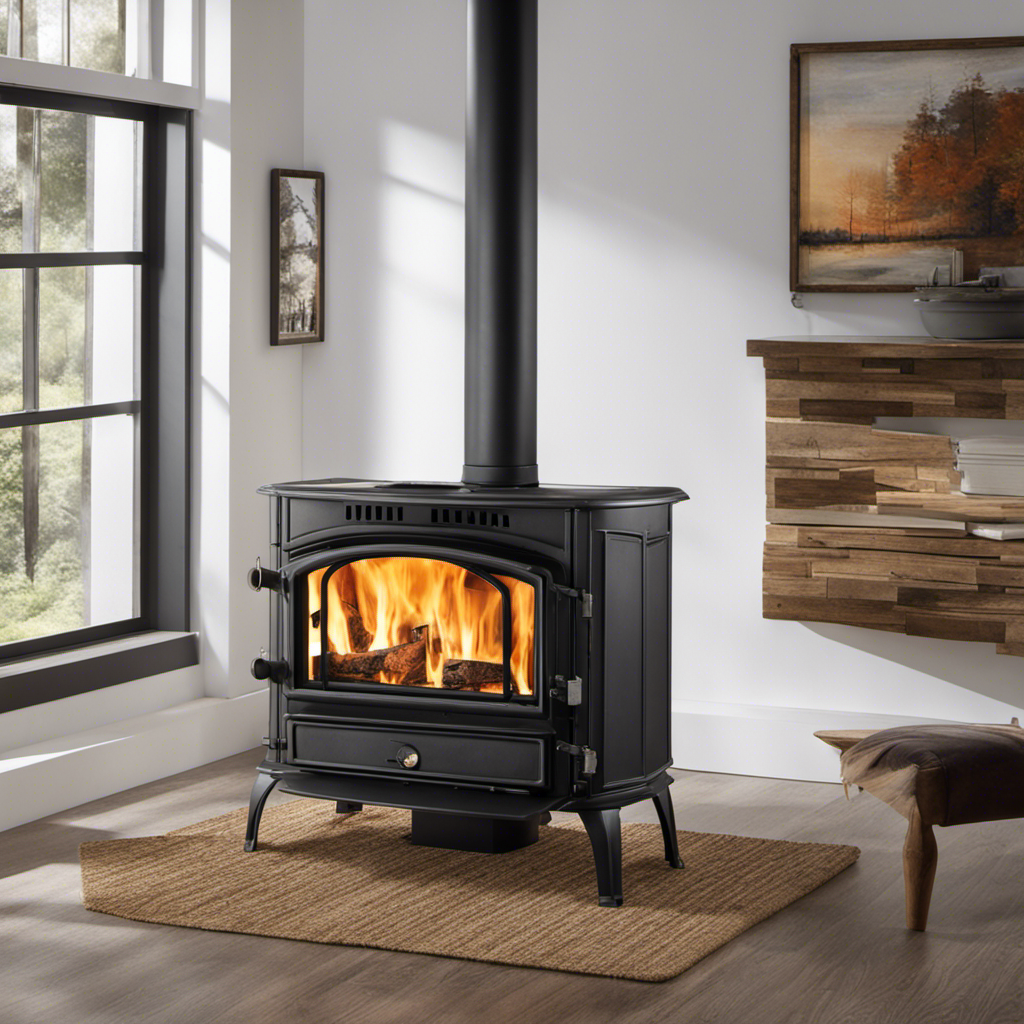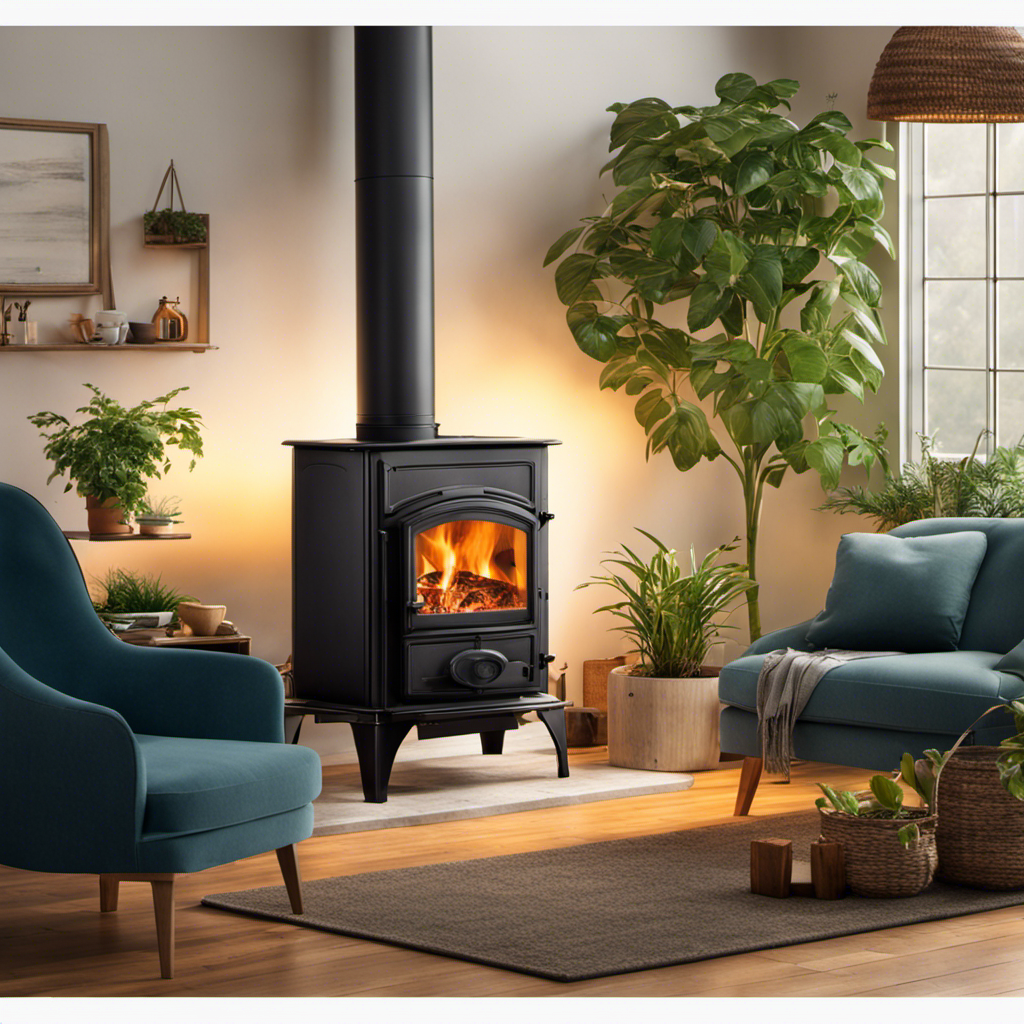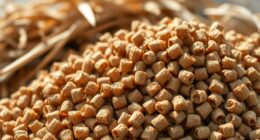As a fan of wood stoves, I frequently ponder the ideal temperature range for their safe use.
Coincidentally, I also wanted to know when it gets too hot and the dangers that come with it.
In this article, I’ll share my findings on how to identify dangerous temperatures, the risks of overheating, and essential maintenance practices to prevent such situations.
Additionally, I’ll provide tips on regulating the temperature and the importance of proper ventilation in controlling heat levels.
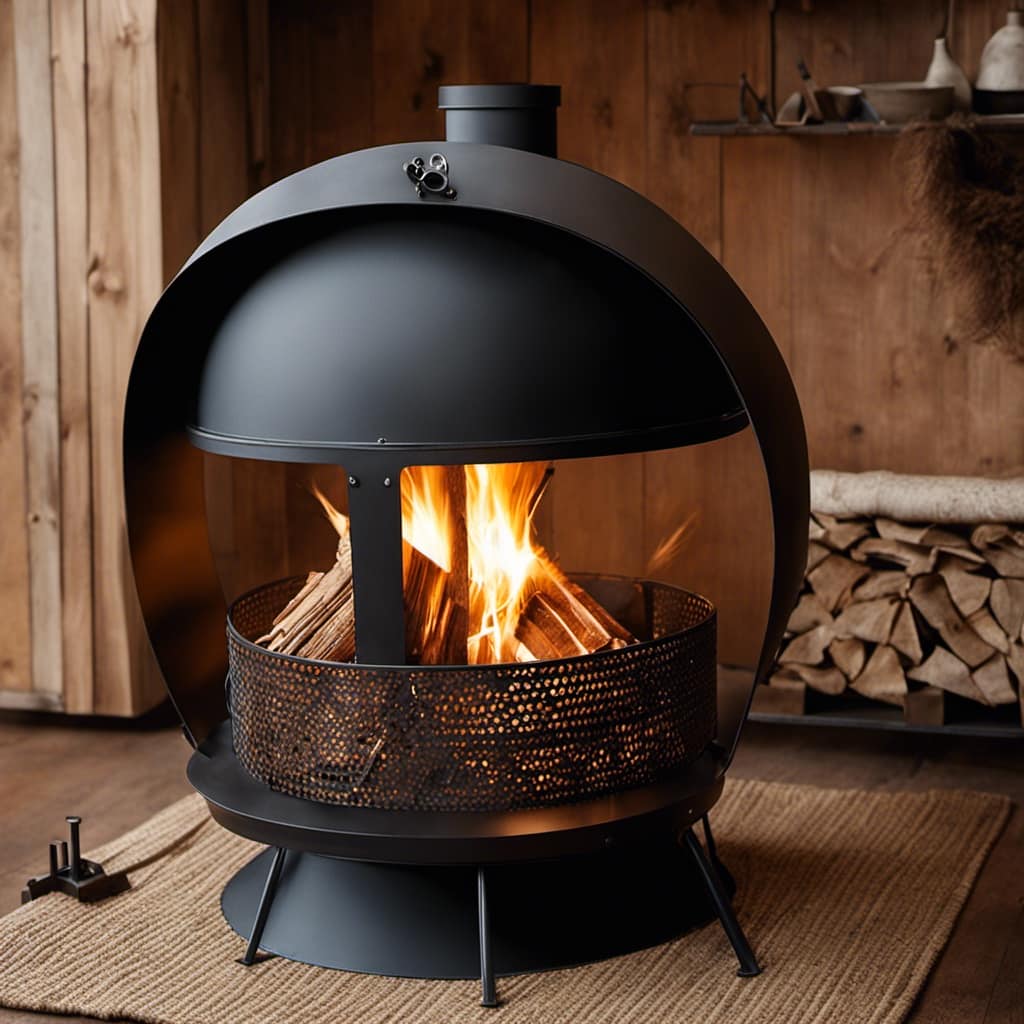
Key Takeaways
- The optimal temperature range for wood stove operation is between 300 and 500 degrees Fahrenheit.
- Operating below 300 degrees Fahrenheit can result in incomplete combustion and the production of harmful pollutants.
- Exceeding 500 degrees Fahrenheit can lead to overheating and pose a fire risk.
- Monitoring the wood stove’s temperature with a thermometer and watching for signs of excessive heat can help prevent dangerous overheating.
The Optimal Temperature Range for Wood Stove Operation
I find the optimal temperature range for wood stove operation to be between 300 and 500 degrees Fahrenheit. Understanding temperature thresholds is crucial in maintaining safe heat levels and preventing any potential hazards. When a wood stove operates below 300 degrees Fahrenheit, it may not burn efficiently, resulting in incomplete combustion and the production of harmful pollutants like carbon monoxide. On the other hand, exceeding 500 degrees Fahrenheit can lead to overheating, which can damage the stove and pose a fire risk to the surrounding area.
Maintaining the wood stove within this temperature range ensures efficient combustion and proper heat output. It allows the wood to burn thoroughly, reducing the emission of harmful gases and particulate matter. Furthermore, operating the stove within this range helps to prevent excessive heat buildup, which can cause damage to the stove’s components and surrounding structures.
To monitor the temperature, it’s recommended to use a stove thermometer. This device provides an accurate reading of the stove’s internal temperature, ensuring that it stays within the optimal range. By regularly checking the thermometer, adjustments can be made to the airflow or fuel supply to maintain the desired temperature.
Understanding the Threshold: When Does It Get Too Hot
In my experience, once the heat becomes unbearable, it’s crucial to understand when a wood stove crosses the threshold and becomes too hot. Managing the temperature of a wood stove is essential for optimal performance and safety.

To help you understand the impact of temperature on stove performance, here are some tips:
-
Monitor the surface temperature: One way to gauge if your wood stove is too hot is by using a surface thermometer. Place it on the stove’s exterior to measure the temperature. Aim for a range between 250°F to 550°F (121°C to 288°C) for efficient operation.
-
Check the chimney temperature: High chimney temperatures can indicate excessive heat. Use a chimney thermometer to monitor the temperature. It should stay below 900°F (482°C) to prevent creosote buildup and reduce the risk of chimney fires.
-
Adjust the air controls: Wood stoves have air vents that regulate the airflow. If the stove is getting too hot, try closing the air vents partially to reduce the oxygen supply. This will help control the combustion rate and lower the temperature.
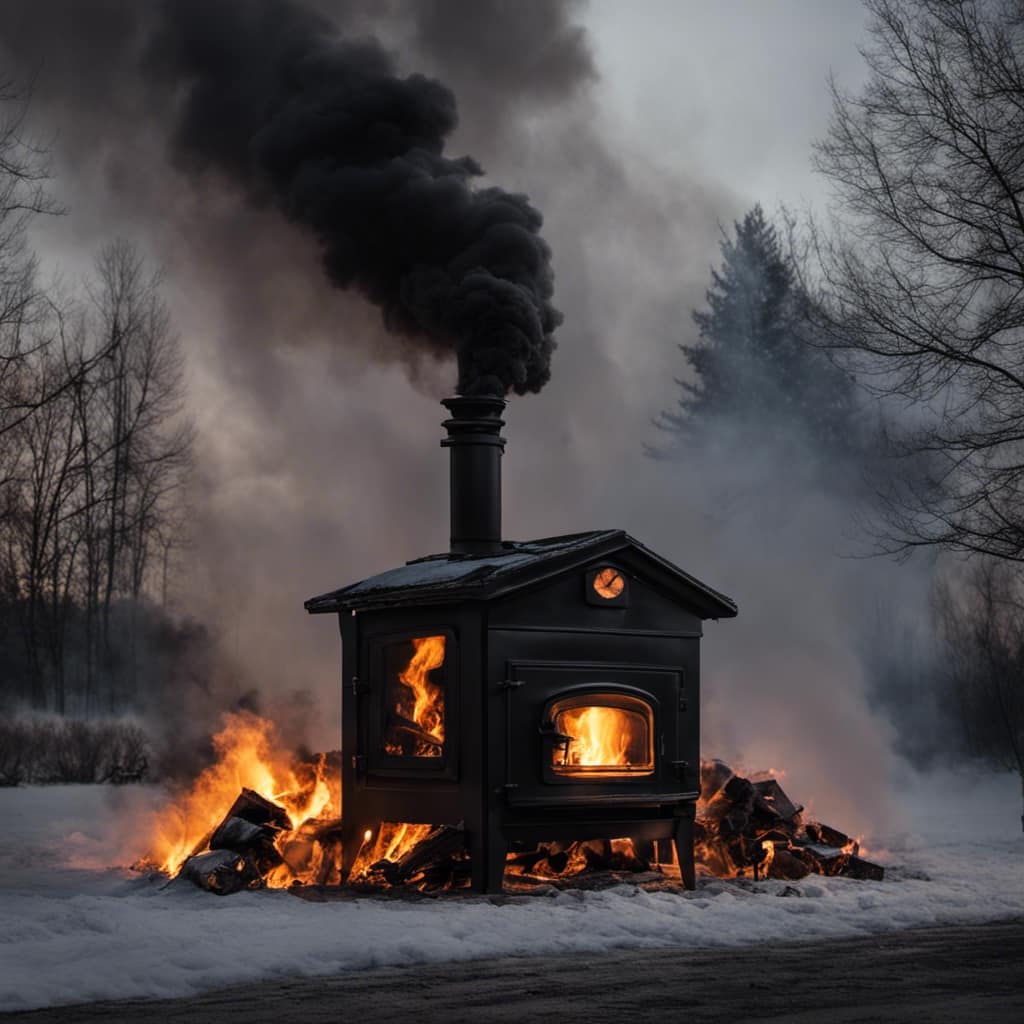
-
Use the right fuel: Different types of wood burn at different temperatures. Hardwoods like oak and maple burn hotter and longer than softwoods. Use the appropriate fuel for your desired temperature range.
Signs of Overheating: How to Identify Dangerous Temperatures
As an expert in the field, I’ve gained extensive knowledge on the signs of overheating and how to identify dangerous temperatures.
It’s crucial to be aware of warning signs and symptoms such as excessive heat, smoke, or unusual odors.
Warning Signs and Symptoms
When my skin feels unusually warm and I start to sweat excessively, these are warning signs that the wood stove may be too hot. It’s important to be aware of these indicators as they can help prevent dangerous overheating and potential health effects.

Here are some warning signs and symptoms to look out for:
-
Excessive sweating: If you find yourself sweating profusely, even in relatively cool conditions, it could be a sign that the wood stove is generating too much heat.
-
Red or flushed skin: When the stove is too hot, your skin may become red or flushed as a result of the increased blood flow near the surface.
-
Feeling uncomfortably warm: If you constantly feel uncomfortably warm in the vicinity of the wood stove, it could indicate that the temperature is too high.

Being vigilant about these warning signs can help prevent dangerous overheating and ensure a safe and comfortable environment.
Preventing Dangerous Overheating
I can prevent dangerous overheating by being mindful of the warning signs and symptoms and adjusting the conditions accordingly. When it comes to wood stoves, it is crucial to maintain a safe operating temperature to prevent accidents and ensure the safety of your home and family. By following proper safety measures, such as regular maintenance and monitoring, you can minimize the risk of overheating and potential fires. Here is a table outlining some key safety measures to prevent dangerous overheating:
| Safety Measure | Description | Importance |
|---|---|---|
| Regular cleaning | Remove ash and creosote buildup to prevent blockages and increase airflow | High |
| Proper ventilation | Ensure proper airflow to prevent overheating and promote efficient burning | High |
| Using a thermometer | Monitor stove temperature to prevent it from reaching unsafe levels | Medium |
Temperature Limits for Safety
Maintaining safe operating limits is crucial to prevent accidents and ensure the well-being of my home and family. To understand the temperature limits for safety in a wood stove, it’s essential to consider the importance of insulation and the principles of heat transfer. Here are three key factors to consider:
-
Insulation: Proper insulation around the wood stove helps to contain and distribute heat efficiently, preventing the stove from getting too hot and reducing the risk of fires or damage.

-
Heat transfer: Understanding how heat is transferred from the firebox to the surrounding environment is essential. Radiant heat, conduction, and convection play significant roles in determining safe operating temperatures.
-
Thermometer: Installing a reliable thermometer on the wood stove allows me to monitor the temperature accurately and stay within safe limits.
Risks and Dangers of Excessive Heat in a Wood Stove
Excessive heat in a wood stove can pose serious risks and dangers. When the temperature inside the stove rises too high, it can result in a number of hazardous situations.
One of the main risks of high temperatures is the potential for a chimney fire. The intense heat can cause the buildup of creosote, a tar-like substance that accumulates in the chimney, to ignite. This can lead to a rapid and uncontrollable fire that can spread to the surrounding areas of the home.

Another danger is the possibility of a stove malfunction. If the stove is exposed to excessive heat, it can cause the metal components to warp, crack, or even melt. This can result in a loss of structural integrity, leading to a potential fire hazard.
To prevent these risks, it’s important to take proper safety precautions. Regular chimney cleanings and inspections can help remove any creosote buildup and identify potential issues before they become a major problem. Additionally, monitoring the temperature inside the stove and ensuring it remains within the recommended range can help prevent overheating.
Preventing Overheating: Essential Maintenance and Safety Practices
To prevent the risk of overheating, it’s essential to regularly clean and inspect the chimney for any creosote buildup and ensure the stove remains within the recommended temperature range. Overheating can lead to a range of problems, from increased fire risk to decreased efficiency and even structural damage to the wood stove itself. By following these maintenance and safety practices, you can prevent accidents and maintain the efficiency of your wood stove.
-
Clean the chimney: Creosote buildup in the chimney can restrict airflow and increase the risk of a chimney fire. Regularly cleaning the chimney, either by yourself or with the help of a professional chimney sweep, will remove this buildup and ensure proper ventilation.
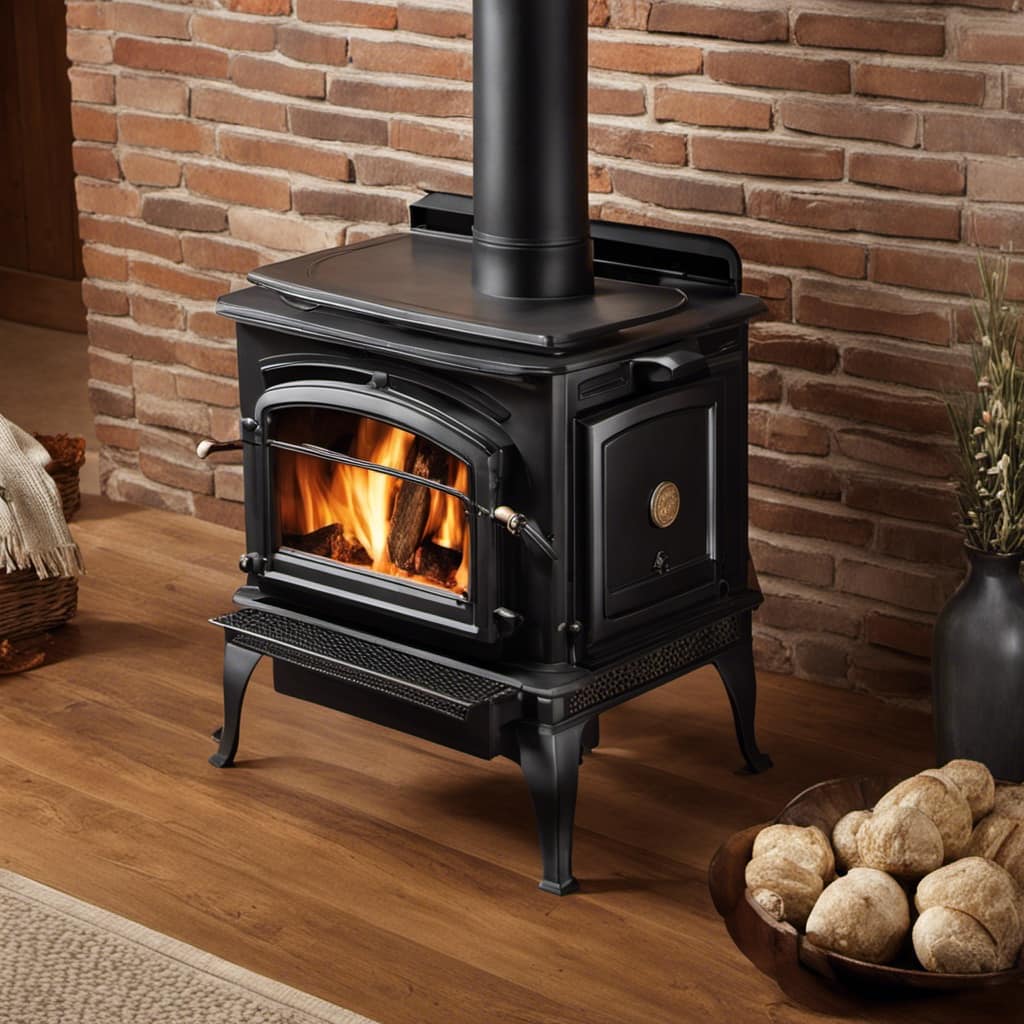
-
Inspect the stove: Check for any signs of wear and tear on the stove, such as cracks or loose fittings. These can contribute to overheating and should be repaired or replaced as soon as possible.
-
Monitor the temperature: Wood stoves come with recommended temperature ranges, usually indicated by a built-in thermometer or a separate temperature gauge. Make sure to monitor the temperature regularly and adjust the airflow or fuel supply to keep it within the recommended range.
Tips for Regulating Temperature in Your Wood Stove
To regulate the temperature in your wood stove effectively, it’s important to understand the airflow dynamics.
Start by adjusting the air vents to control the amount of oxygen entering the stove. Opening the vents fully will increase the temperature, while closing them will reduce it.

Additionally, using the correct fuel and maintaining a clean stove will help optimize temperature regulation and prevent overheating risks.
Optimal Stove Temperatures
I find that maintaining the right temperature in my wood stove is crucial for optimal performance. The optimal heating of a wood stove can be achieved through proper temperature control. Here are some key factors to consider:
-
Airflow: Ensuring proper airflow is essential for regulating the temperature in a wood stove. Adjusting the damper or air vents can help control the amount of oxygen entering the stove and therefore the rate of combustion.
-
Fuel type: Different types of wood burn at different temperatures. Hardwoods like oak and maple burn hotter and longer than softwoods like pine. Choosing the right fuel for your stove can help maintain the optimal temperature.

-
Stove design: The design of the stove, including the size and arrangement of the firebox and the presence of secondary air supply, can affect its heating ability. Understanding your stove’s design can help you better control the temperature.
Avoiding Overheating Risks
As an owner of a wood stove, it is important to be mindful of potential risks associated with overheating. Preventing accidents and managing heat levels are crucial for the safe operation of a wood stove. To help you understand the temperature ranges and associated risks, here is a table summarizing the various heat levels and their implications:
| Heat Level | Temperature Range | Risks |
|---|---|---|
| Low | 200-250°F | Inefficient combustion, increased creosote buildup, poor heat output |
| Moderate | 250-400°F | Optimal combustion, efficient heat output, reduced creosote buildup |
| High | 400-600°F | Increased risk of overheating, potential damage to stove and flue |
| Extreme | 600°F+ | Severe risk of overheating, potential fire hazard, damage to surroundings |
The Role of Proper Ventilation in Controlling Heat Levels
I’ve found that proper ventilation plays a crucial role in controlling heat levels when using a wood stove. Without adequate ventilation, the heat generated by the stove can quickly become overwhelming, leading to a range of issues including discomfort, damage to the stove, and even fire hazards.
Here are three key reasons why proper ventilation is essential for heat control:

-
Prevents overheating: When a wood stove isn’t properly ventilated, the heat produced during combustion can accumulate rapidly, leading to excessive temperatures. This can make the room uncomfortably hot and potentially damage surrounding materials. By ensuring proper ventilation, excess heat can be effectively removed, maintaining a comfortable and safe environment.
-
Promotes efficient combustion: Proper ventilation enables a steady flow of oxygen to the fire, allowing for efficient combustion. This not only maximizes the heat output but also helps to control the overall temperature. Adequate air supply ensures that the wood burns at the optimal rate, preventing the stove from getting too hot.
-
Reduces the risk of carbon monoxide buildup: Incomplete combustion can result in the release of carbon monoxide, a dangerous gas that’s both odorless and colorless. Proper ventilation helps to remove this toxic gas from the room, minimizing the risk of carbon monoxide poisoning. It also ensures the wood stove operates safely and efficiently.
Troubleshooting: Common Issues and Solutions for High Temperatures
One common issue that can occur when using a wood stove is excessive heat, but troubleshooting the problem can help find a solution. When faced with high temperatures, there are several troubleshooting tips that can help pinpoint the common causes and address the issue effectively.

One possible cause of excessive heat is an over-firing stove. This occurs when too much fuel is being burned, resulting in a higher heat output than desired. To troubleshoot this issue, it’s important to check the air controls and ensure they’re properly adjusted. Adjusting the air controls can regulate the amount of oxygen entering the stove, thus controlling the burn rate and reducing excessive heat.
Another common cause of high temperatures is a restricted chimney or flue. A blocked or partially blocked chimney can hinder the proper venting of the stove, leading to a buildup of heat. To troubleshoot this issue, inspect the chimney and flue for any obstructions such as creosote buildup or debris. Cleaning the chimney regularly can prevent blockages and ensure proper venting, maintaining optimal heat levels.
Additionally, the type and quality of wood used can also contribute to excessive heat. Certain types of wood, such as softwoods, have higher BTU values and can produce more heat than desired. Using hardwoods or properly seasoned wood can help regulate heat levels and prevent overheating.
Frequently Asked Questions
How Does the Temperature of a Wood Stove Affect Its Performance and Efficiency?
When it comes to temperature’s impact on wood stove performance, it plays a crucial role in determining how efficiently the stove operates. A wood stove needs to reach and maintain a specific temperature range to function optimally.

If the temperature is too low, the combustion process may be incomplete, leading to poor efficiency. On the other hand, if the temperature is too high, it can damage the stove and potentially cause a fire hazard.
Therefore, understanding how to optimize wood stove efficiency is essential for both safety and effectiveness.
Can Overheating a Wood Stove Lead to Damage or Malfunctioning of the Stove?
When it comes to the risks of overheating a wood stove, it’s important to consider the potential damage and malfunctioning that can occur. Proper maintenance practices play a crucial role in preventing these issues.
Understanding the limits of temperature is key, as exceeding these limits can lead to damage, such as warping or cracking of the stove components. Regularly checking and maintaining your wood stove will help ensure its longevity and efficient performance.

Are There Any Safety Concerns Associated With Operating a Wood Stove at High Temperatures?
Safety concerns and maintenance practices are crucial when operating a wood stove at high temperatures. It’s important to ensure proper ventilation to prevent the buildup of harmful gases and reduce the risk of carbon monoxide poisoning.
Regularly inspecting the stove for any signs of damage or malfunctioning is essential for maintaining safety. Additionally, practicing safe fuel usage and adhering to manufacturer recommendations can help prevent overheating and potential hazards associated with operating a wood stove at high temperatures.
What Are the Potential Risks or Dangers of Using a Wood Stove That Is Too Hot?
Using a wood stove that’s too hot can pose significant risks and dangers. The intense heat can lead to overheating, which can cause damage to the stove itself, as well as nearby furniture or walls.
Additionally, the high temperatures can increase the risk of fire, as combustible materials may ignite more easily. It’s important to monitor the temperature of a wood stove and ensure it remains within a safe range to prevent these potential hazards.

Are There Any Specific Maintenance Practices or Safety Measures That Can Help Prevent Overheating in a Wood Stove?
When it comes to maintaining a wood stove and preventing overheating, there are several key maintenance practices and safety measures to keep in mind.
Regular cleaning and inspection of the stove and chimney is crucial to ensure proper airflow and prevent blockages.
Using the right type and amount of fuel can also help regulate the temperature.
Installing a heat sensor or thermometer can provide real-time temperature readings and alert you if it gets too hot.

Additionally, ensuring proper ventilation and using safety barriers around the stove can minimize the risk of accidents.
Conclusion
In conclusion, maintaining the optimal temperature range for a wood stove is crucial for safe and efficient operation.
Just like a skilled conductor guiding an orchestra, proper regulation of heat ensures harmony and prevents potential hazards.
By understanding the signs of overheating, practicing essential maintenance, and ensuring proper ventilation, wood stove owners can enjoy the warmth and comfort of their fires while minimizing the risks associated with excessive heat.

Growing up surrounded by the vast beauty of nature, Sierra was always drawn to the call of the wild. While others sought the comfort of the familiar, she ventured out, embracing the unpredictable and finding stories in the heartbeat of nature.
At the epicenter of every remarkable venture lies a dynamic team—a fusion of diverse talents, visions, and passions. The essence of Best Small Wood Stoves is crafted and refined by such a trio: Sierra, Logan, and Terra. Their collective expertise has transformed the platform into a leading authority on small wood stoves, radiating warmth and knowledge in equal measure.




